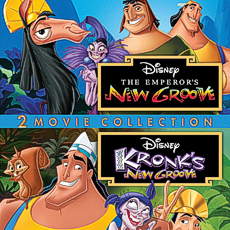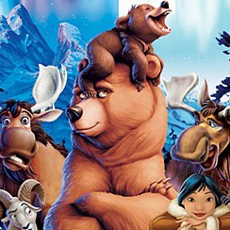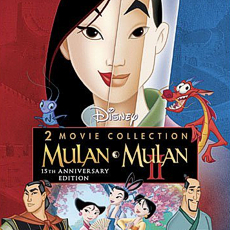Walt Disney Feature Animation (December 10 2000), Walt Disney Home Entertainment (June 11 2013), Blu-ray plus two DVD set, 78 mins plus supplements, 1080p high-definition 1.66:1 widescreen, 5.1 DTS-HD Master Audio, Rated PG, Retail: $29.99
Storyboard:
The vain, powerful and comically flippant ruler of an Incan empire learns a few rules about life and friendship, in an epic and very funny road movie.

The Sweatbox Review:
By design or not, all three of Disney’s June 11 Blu-ray upgrade titles (The Emperor’s New Groove, Atlantis: The Lost Empire and Lilo And Stitch) have several elements in common. Firstly, they represent the “Disney canon” titles of successive years, Groove being released in 2000, the second two respectively in 2001 and 2002. They also somewhat marked the end of the 1990s Disney renaissance, when the Studio’s films – on a high since the decade’s early one-two-three-punch of Beauty And The Beast’s Best Picture nomination, the commercial success of Aladdin and the record-breaking phenomenon of The Lion King – saw declining returns on the next few features (films that, in retrospect, were probably too seriously minded at trying to be the next Beauty or Lion to succeed in an animation landscape that was becoming dominated by CGI comedies).
However, and here’s the thing…they were all bigger hits, albeit Atlantis more moderately so, than most of the films that had come immediately before. Tarzan, in 1999, was arguably the last hurrah of the kind of vibe that had defined the technological, artistic and commercial breakthroughs of the Studio’s past ten years or so. Although hits, the likes of Pocahontas, The Hunchback Of Notre Dame, Mulan and Hercules had proved less successful in the second half of the 1990s, when Pixar’s rise had resulted in Toy Story, A Bug’s Life and Toy Story 2. The Emperor’s New Groove itself had begun life as an immensely sombre outing, intended to be an epic drama that would compete with Disney’s previous Studio head Jeffrey Katzenberg’s new DreamWorks Animation’s take on The Ten Commandments, The Prince Of Egypt.
At Disney, Katzenberg had spearheaded the creative impetus that powered Disney to its enormous critical and commercial success in the 1990s. The Oscar nomination, but ultimate losing to The Silence Of The Lambs, for Beauty propelled him to find a project that could win the award, the feeling being that it should be a picture with mature intent so that it could be taken seriously as an awards contender. By the end of the 1990s, internal politics meant Katzenberg had left the Mouse House, continuing his pursuit with Prince and, ultimately, somewhat fulfilling his intention by winning the first Best Animated Feature prize with Shrek. Several projects instigated by Katzenberg were still on the drawing boards, naturally, when he departed, and Kingdom Of The Sun was one of them…

Directed by The Lion King’s Roger Allers and with songs by Sting, brought in during a period following Lion’s success with Elton John and the similar approach to Tarzan with Phil Collins, Kingdom Of The Sun was now facing story problems. It’s not an issue uncommon to any animated film’s production, of course, but the overall feeling was not necessarily that Kingdom’s story lagged in any particular place, but that its actual tone was just too down in the mouth to sustain what should have been a broad family adventure. As with many animated films, production was shut down for a bit of retooling. Unlike many animated films, this would involve essentially cancelling the movie altogether, since the result would now change beyond recognition, causing the villainesses’ animator Andreas Deja to leave for the Florida unit’s Lilo And Stitch.
Allers also moved on (and, ultimately, completely away from the Studio) and one-time animator, now director, Mark Dindal was brought in, using several character and scene elements to spin the movie in a total 180 degree direction, turning a dark and serious story into its complete opposite. Literally bringing an entirely new groove to the production, Kingdom Of The Sun became The Emperor’s New Groove, the Prince And The Pauper-styled story becoming a flippant, all-out, laugh a minute comedy full of “anything and everything” random moments. This process, documented as per Sting’s contractual agreement with the Studio by his wife Trudi Styler, was captured in the practically never seen behind the scenes feature The Sweatbox; Styler was given unprecedented access to the film and its creators, and pieced together a warts and all account of Kingdom’s production and eventual switch to Groove.
One of the biggest creative upheavals was infamously captured by Styler’s camera: the phone call that told her husband that because of character and story changes, the six songs he had composed for the movie – including the sensation song for villainess Yzma, Snuff Out The Light, which would eventually be heard on the soundtrack album – would not work for the film they now had in mind and would have to be cut. Even worse, he was asked to contribute two new songs to the film, adding insult to injury. Sting relented, although ironically those two new songs, Perfect World and My Funny Friend And Me, don’t progress the movie along or add anything specific: indeed, while My Funny Friend And Me is referenced throughout John Debney’s score, the song remains simply a reason to have an artist of Sting’s caliber provide a pop single to sing over the movie’s end credits.

Despite these many changes, ultimately there aren’t many films like The Emperor’s New Groove in the Disney line-up and, coming so far from out of left field, it wound up surprising both audiences and the Studio alike. More akin, if we look back on Disney’s history, to the kind of knockabout cartoons such as Dumbo, The Jungle Book, Aladdin or Hercules that had heart but didn’t take themselves too seriously (a line that can continue to be traced through more recent films as Meet The Robinsons, Bolt and Wreck-It Ralph), Groove’s hip and edgy tone struck a chord with moviegoers, who seemed to respond to its comedic elements and surprised Disney by turning it into an unexpected hit, outgrossing the supposed sure-fire sequel 102 Dalmatians that Groove had been unceremoniously dumped out alongside and inspiring a video sequel and television series, The Emperor’s New School.
For whatever went on behind the scenes, Groove ultimately succeeds as a movie entertainment precisely because of this seat-of-their-pants, no-time-to-make-the-movie, anything goes attitude. There’s a totally flippant charm to the film, with gags flying all over the place, and a Looney Tunes outlook that meshes unexpectedly well with the typically smooth and fluid Disney animation: I have a feeling that Chuck Jones and Tex Avery would have been proud to have their names on this. Ironically, Dindal had just come back to the Studio from Looney Tunes’ home at Warners, where he had helmed the fun, golden age Hollywood pastiche Cats Don’t Dance, so his naming as the director of Disney’s film was a clear indication of the direction they preferred. (Dindal, of course, would later be in the receiving end of the same kind of treatment, when his Chicken Little went through several reiterations, to less successful results.)
If anything, Groove’s visual approach takes on a slight UPA feel, certainly influenced by the more angular style of the 1950s, albeit with the lush Disney look of their 1990s “tradigital” pictures. It’s unclear how all the characters were changed from their initial concepts, but somehow they all fall into place in this newly grooved version: the Emperor, Kuzco, is a spoiled brat who continues to talk when he is transformed into a llama by his twisted and power-hungry royal advisor Yzma and her hilariously inept henchman Kronk, the film’s breakout character and a star-making role for veteran vocal artist Patrick Warburton. Finding himself at the mercy of Pacha, a peasant llama herder who had come to Kuzco’s palace to ask for help, the mismatched odd couple find themselves thrown together to achieve their aims, setting out across the kingdom to restore Kuzco to his rightful human form and place, while Pacha (John Goodman) seeks Kuzco’s word that he won’t trash his home to install a new pool.
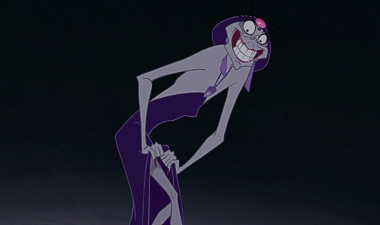
Yes, just when you think that the film’s synopsis sounds like a nice and typical Disney story, there’s an unexpected element like a new pool thrown into the mix, and it’s the best way to describe the overall movie. Many references abound in the most comical ways (particularly one from The Wizard Of Oz), and in Eartha Kitt’s portrayal as Yzma as an aged hag only just about holding her once youthful looks together, the Studio has found the most outrageous villainess since Cruella De Vil in One Hundred And One Dalmatians. As Kuzco, David Spade isn’t necessarily one of the film’s strong points, but Kitt steals the show…her painfully vain sorceress of sorts is the most fun Disney baddie in years (“you weren’t expecting…this!”), deliciously attempting various attempts and schemes to rid herself of the annoying Kuzco so that she can take the throne.
As her sidekick, Warburton impresses as Kronk (“Riiiiiiiiiiiiiiiiiiiiiiiight…”) before he would become too ubiquitous an animation voice in everything from Family Guy to practically all of Disney’s next few following films and those from their DreamWorks rivals. Revisiting the movie, his Kronk still sounds fresh, mostly down to the film’s crazy plotting and pacing, which allows for various sight gags and a hysterical moment of farce in a stop-off eatery. Not that the film is all comedy, comedy, comedy: Groove finds room for a sub-plot between Pacha and his family, and there’s a truly exciting chase sequence towards the end, when Yzma’s magic causes more chaos than even she expects, resulting in some more very funny moments, especially when a guard asks to be excused from proceedings due to having been turned into a cow as if it’s the most normal thing in the world.
Although plagued by production difficulties, The Emperor’s New Groove averts potential disaster by simply playing it fast and wide and broad for pretty much all of its length. It’s the animated equivalent of those “everything in and the kitchen sink” films like It’s A Mad, Mad, Mad, Mad World or Spielberg’s 1941…big messy movies that appeal to certain audiences. If anything, Groove has even more appeal: it’s ultimately a cohesive story, surprising given its fractured history, and is tighter than either of those out-of-control epics. Kudos must go to Dindal and his producer Randy Fullmer: although they had to scrap much and go through production heck, they emerge on the other side with an extremely entertaining product!
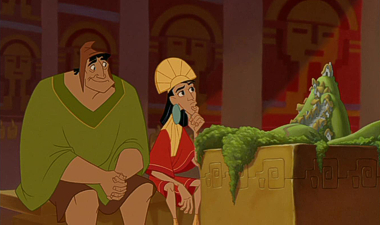
Is This Thing Loaded?
Hopefully not suggesting the new way of packing discs with content – or not! – at Disney Home Video, The Emperor’s New Groove comes with a stunning lack of any extras whatsoever! At least the Studio has finally accepted that we don’t see their direct-to-video sequels as anything more than supplements, though, since the addition of the 75-minute Kronk’s New Groove in this 2-Movie Collection is clearly as a bonus feature as depicted on the back of the sleeve, despite its half-and-half sharing the front cover with its theatrical sibling. Not arriving on home video until 2005 – some five years after the original had made an outrageously successful showing on home video – and actually set within this same timeframe, we find the couple-of-reels-short-of-a-final-cut Kronk heading up Mudka’s Meat Hut, the restaurant that featured in the farcical “dinner sequence” in the original.
As this new story begins, it seems Kronk’s Dad is about to pay his boy a visit, expecting to find his son successfully set up with home, family and top flight job. Of course, that’s a far cry from the Kronk we find here: covered in cheese from an exploding pizza he was about to serve up, and, while not under the employ of a scheming witch any longer, he’s still not a self-made man and prefers helping out his friends than taking the lead. This looks like it could change when Yzma, still affected somewhat by her backfiring spell from end of the original, slithers back into Kronk’s life and attempts to make a wacky comeback by using her old henchman to fool the locals into investing in her (very suspect) youth potion. Naturally, Kronk’s good side prevails, and Yzma is chased off into the sewers (no doubt to make another comeback in the TV spin off).

Moving on to Camp Chippamunka (cue more of Kronk’s unique squirrel language antics), the big guy comes up against Ms Birdwell’s team of Junior Chipmunks, and finds that his thus untapped need to impress unleashes a competitive animal that strives too hard to push his team, leading to trouble that sees Kronk in hot water with Ms Birdwell. Finally, the day for Papi’s visit arrives, and while Kronk’s reflections have led him to feel he’s been a failure, his friends band together to prove that he’s a success in many other ways. The story threads all come to a neat resolve, and perhaps predictably, Kronk ends up as the cat that ate the cream (while Yzma, presumably, just remains a cat).
While one could easily argue that Kronk’s New Groove, presented in a fine 1.78:1 widescreen transfer, only added to the long list of uncalled for franchise continuations to Disney’s theatrical hits, the total reunion of the original voice cast (however small some of their roles may be), and some quality animation that proves the DisneyToon Studio was close to being able to produce full features towards the end of their hand-drawn period, does actually provide a fitting second outing for these characters. Taking into account the original’s freewheeling style certainly helps to overcome the initial instinct to perhaps roll the eyes at yet another DTV effort, but at least it steers well clear of repetition (in story if not style) and just about stands up on its own.
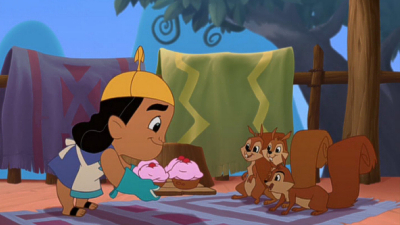
The Emperor’s New Groove seemed to play with the conventions of filmmaking (either intentional or as part of the clever Kingdom cover up attempt) as well as conveying a proper story arc that involved the audience, and that same playing with the way narrative works in Kronk’s very much keeps things in tone with the first flick. We are given a quick update on Kronk’s adventures since we last saw him, helped by a hip and happening intro song that reflects the original’s Perfect World opener (here, the Tom Jones MC has been updated with an equally soul-blessed sister singer), and the first half of the film plays out rather well, with a wonderful boost given by the always-hysterical Yzma, again played with tongue fully in cheek by Kitt.
Once she’s been “disposed of” – almost quite literally – the movie moves into a slower mode for its second half, and while the scriptwriters inevitably find a love interest for Kronk, the shift feels a little more disjointed to the overall drive of the movie. However, as derivative as Kronk’s New Groove turns out to be, it isn’t the mess it could have been either, and at least brakes free of the “mid-quel” territory that plagued so many of these Disney offshoots. In fact, and taken on its own merits, Kronk’s New Groove is pretty fun stuff in itself, with some nice self-references to the original that would have helped this feel like a proper sequel as opposed to some TV-spin off if it weren’t for its not much more than an hour running time.

That said, this is a good hour of animation, being of the crisper DTV variety that was streets ahead of the “black marker” approach to old-school Mouse House TV cartooning and so disappointing in the likes of the Hunchback and Pocahontas sequels. Not all the gags work…Kuzco hardly makes an appearance, and Pacha only turns up in the bookends, leaving Kronk front and center for the most part, aided by Yzma in the first half and Ms Birdwell in the second. The overall “threat” of having his father turning up to inspect what Kronk has made of his life doesn’t really set up as much of central drive for events to transpire, something that the movie also stumbles on in its episodic nature.
Kronk himself, while a great support, is a one-note joke, and though Warburton enthuses him with as much eagerness as first time out, I’m not sure that an entire movie resting on such a character’s broad shoulders was the best way to explore the material assembled here. The other voices – most notably Kitt’s returning Yzma and newcomers Tracey Ullman (as Birdwell) and Frasier’s John Mahoney, as Kronk Sr, put in good work and make the most out of the often very amusing script, while long time Winnie The Pooh voice contributor John Fiedler will jump out at Piglet fans in what were probably among the last lines of dialogue he recorded.

The songs are also cool, the jokes are good, and I found several moments in there that really made me laugh out loud, with some truly memorable sequences that really have no place in what some might have seen as a cheap knock-off. Even if Kronk’s New Groove doesn’t always reach the heights of the original, at least it provides a follow-up story as opposed to a re-hashed transformation tale, albeit one that relies heavily on the tone and conventions of the earlier film, with a slight edge that sees some surprisingly “adult” laughs thrown in (don’t worry – there’s nothing that jeopardizes the G rating here) in the form of movie references, Disney digs and more of the random, truly funny humor that made the first film such a hit.
The real bad news is that Kronk’s New Groove is it for the “extras” on this disc, leaving it to the two included DVDs (for each feature) to pick up the slack. Far from being as packed as The Emperor’s New Groove’s initial two-disc DVD package released back in the days when every new Disney feature got that kind of treatment, this disc is a replica – complete with dated previews – of the single disc released to tie in with the DTV film. It still retains a healthy share of extras, including over 12 minutes of three Deleted Scenes, two Music clips (one on Sting’s song, one on learning to “walk the llama”), a fairly amusing set-top game voiced by Kitt and Warburton, a trio of Behind The Scenes featurettes (around nine minutes, covering the Research Trip, Character Voices and CGI) and a full-length Audio Commentary with Dindal, Fullmer and several other crewmembers.

On the DTV sequel’s disc, the set-top Kronk’s Brain Game is a simple (in concept and execution) collection of tasks, while a Pyramid Scheme game is perhaps most notable for introducing JP Manoux as the voice of Kuzco for The Emperor’s New School. There’s no commentary track, but we do meet co-directors Saul Blinkoff and Elliot Bour, joined by Warburton, for a detailed (if brief, at eight minutes) How To Cook A Movie featurette, highlighting in an amusing fashion the process from storyboards to final mixing. However, that’s it for the groove in this set: while it’s predictable – if a great shame – that The Sweatbox still couldn’t be included, it does seem a great shame that not even the Commentary for the original movie has been carried over, meaning that you have to forgo the HD quality to listen to the filmmakers’ otherwise informative and interesting remarks.
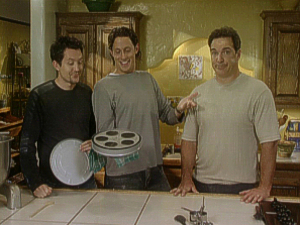
Case Study:
From the front of the slipcovered sleeve, you’d think this was a Disney Blu-ray upgrade just the same as the many other recent such releases…but look carefully and there seems to have been a shift in priorities at Disney Home Video, for the back of the cover has done away with the Combo Pack graphic table-listing of what can be found on each included disc. Instead, and while the sequel movie gets equal billing on the front, the back tells a different story, relegating it to bonus feature status without much more than an “also includes” kind of strapline. Worse, it’s on the back that the lack of Blu-ray extras makes itself known, while not confirming that the included DVDs feature anything of note either! It’s a really insipid and generic way to package a movie, and the general vagueness even stretches to the technical specs: look carefully and you might spot the DTS logo but nowhere on the whole package will you find either of the movies’ aspect ratios.
Ink And Paint:
Without the aspect ratios listed on the packaging, one has to go by looking at the screen dimensions on the screen but it’s fairly safe to say that The Emperor’s New Groove retains its native 1.66:1 ratio of the original DVD, while Kronk’s New Groove is also native at the 16:9 home video ratio of 1.78:1. Both exhibit terrifically sharp transfers: Emperor’s wins with its more layered artwork, with Kronk’s flatter and more simple approach revealing its DTV origins. As is to perhaps be expected in traditional, shaded animation, banding does occur in some shots, while more surprising given the lack of material on the disc (just the two HD movies and a scant number of previews) is a small amount of mosquito noise that I noticed when the banding reared its head. Otherwise these follow the spotless protocol of Disney’s other BD upgrades: perhaps a bit too sharp to show off each individually animated line, but pristine nonetheless, as one would hope with little other incentive to buy the set.
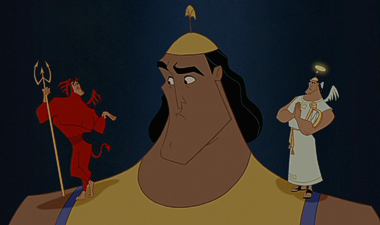
Scratch Tracks:
The Emperor’s New Groove sounds as wonderfully lush as its jungle-set scenes, the dialogue pushed to the fore as it should be for such a line-heavy, joke-filled movie. Debney’s score bolsters the comedy angles, the DTS allowing everything to hit hard and fast as it should. Kronk’s repeats the front-heavy approach but isn’t anywhere as cinematic, essentially re-running the energetic DTS track from its initial DVD release. Dubs and subs are also offered in French and Spanish, with additional English subtitles.
Final Cut:
Perhaps not a Disney classic in the true sense, The Emperor’s New Groove is still a unique film in the Studio’s line-up, finding a place for itself and being as different as could be to its two concurrently released stable mates, Atlantis: The Lost Empire and Lilo And Stitch. The unique aspect here is comedy – and much of it – taking an unfortunate situation in a project that had become stagnant and turning it around to produce something so flippant that its exuberances can only win over any viewer.
After the packed original two-disc DVD edition and the later, pared down reissue included here, it’s extremely disappointing that the only extras are to be found on the bundled-in DVDs which, given a similar treatment to Lilo And Stitch may unfortunately be the way the Studio is moving forward with these two-movie original feature and DTV sequel packs. The original Groove wins healthy points, while Kronk’s scores less, while it’s pretty hard to rate this set at all given the lack of supplements on the actual Blu-ray.
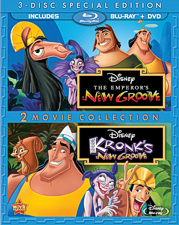 | ||
 |


